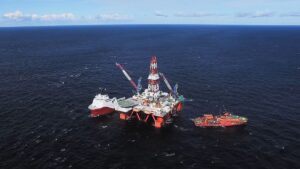Desculpe, este conteúdo só está disponível em English. For the sake of viewer convenience, the content is shown below in the alternative language. You may click the link to switch the active language.
You often find stainless steel in marine applications and there is good reason for this. It is widely recognised as the ideal material for marine applications because it has excellent corrosion resistance as well as good stability, appearance, durability, lustre, strength and stiffness.
Marine environments can be very demanding, with factors like high salt content, water flow rates, pressure and temperature all coming into play. Stainless steel structures can usually withstand these factors and ensure that complex projects can go ahead that may otherwise be impossible.
As an example of stainless steel in marine applications, grade 304 stainless steel is often used as the material for fittings in boating applications, whereas 316 stainless steel (UNS S31600/S31603 – commonly termed ‘marine grade’ stainless) can be found in approximately 90% of marine applications. 304 and 316 stainless steels are austenitic metals which can be seen due their metallurgical structure which means they possess excellent ductility, good strength, non-magnetic properties, good weldability, and very good corrosion resistance.
Duplex Stainless Steel is also widely used in marine applications, usually ones that require a higher yield strength and better corrosion resistance.
As well as boating applications, stainless steel can be found far and wide in marine applications, in everything from oil rigs, piers and vessels to floating homes.
Read the rest of this blog to find out more about stainless steel in marine applications.
Stainless steel is ‘fit for purpose’
There are lots of factors to consider when choosing which type of stainless steel is right for your project. These include:
- ▶️ Seawater quality
- ▶️ Water flow rates
- ▶️ Water temperature
- ▶️ Water oxygen levels (deaeration)
- ▶️ ‘Engineered’ crevices (surface finish and post fabrication cleaning)
- ▶️ Cathodic protection
There are many different types of stainless steel, and each one has different advantages and uses. Look at these examples:
- ▶️ 304 stainless steel is ideal for applications such as coastal service environments, splash zone applications and intermittent submersion in seawater. It can often the metal used for fully exposed components that are frequently washed with fresh water.
- ▶️ Super-austenitic stainless steels like 6% moly are recommended for applications where they will be permanently immersed in seawater. 6% Moly is a super-austenitic stainless steel which contains at least 6% molybdenum. 6% Moly alloys have exemplary resistance to a number of chemicals and are particularly appropriate for environments such as brackish water, seawater, pulp mill bleach plants that present a high chloride condition.
- ▶️ Duplex stainless steels (e.g., ASTM S31803) offers higher strength meaning that lighter weight components can be used for the same applications as 316. It is common to find duplex stainless steels in marine applications, especially in brackish water, such as in estuaries where the chloride content of the water is less than that of the open sea.
- ▶️ Super duplex stainless steels (e.g., ASTM S32750) offers even higher strength and weight savings that duplex and is able to withstand all the challenges of marine environments, with no risk of corrosion even in tropical waters and hot, wet exhaust applications. They can even be used in direct and prolonged contact with seawater such as offshore oil platforms.
Examples of stainless steel in marine applications
There are many different types of marine applications:
- ▶️ Coastal applications such as handrails, housings for equipment, ladders, lamp posts.
- ▶️ Deck components for boats and ships e.g., deck eyes, brackets for anchor ropes, housings for equipment, shackles, handrails.
- ▶️ Submerged items such as pipelines and grills for oil, sewage and water, risers for oil platforms, grills, heat exchangers for ships and coastal power plants, equipment attached to hulls of boats and ships.
- ▶️ Prolonged contact items such as pumps, winches, holding and storage vessels.
Corrosion
Corrosion is one of the main ‘enemies’ that have to be fought against in marine environments. Consequently, it is one of the main reasons why stainless steel is used.
There are different types of corrosion that must be combatted. Interestingly, many corrosion problems can be avoided by use of cathodic protection.
Some of the different types of corrosion are:
- ▶️ Localised: This can manifest either as pitting corrosion or crevice corrosion. Pitting corrosion is a localized form of corrosion by which cavities or “holes” are produced in the material. Crevice Corrosion is the localised attack on a metal surface at, or adjacent to, the gap or crevice between two joining surfaces, such as around the edges of nuts and rivet heads. Many stainless steels are very good at resisting both pitting corrosion and crevice corrosion in marine applications.
- ▶️ Stress corrosion cracking: Stress corrosion cracking (SCC) is the cracking of a metal which is induced from the combined influence of tensile stress and a corrosive environment. Stainless steel 304 and 316 are sensitive to chloride cracking, whereas duplex stainless steel and 6% Moly are less likely to succumb to it.
- ▶️ Galvanic Corrosion: Galvanic corrosion is an electrochemical process in which two dissimilar materials are brought together and one metal corrodes the other. It often occurs when different metals are brought into electrical contact under water. f two stainless steel grades of similar type are galvanically coupled, there is usually no risk of galvanic corrosion.
Speak to the Special Piping Materials team today either in Aberdeen, Manchester, Dubai, Brazil, Texas, Perth or Singapore about your marine project and stainless steel requirement.



 English
English
